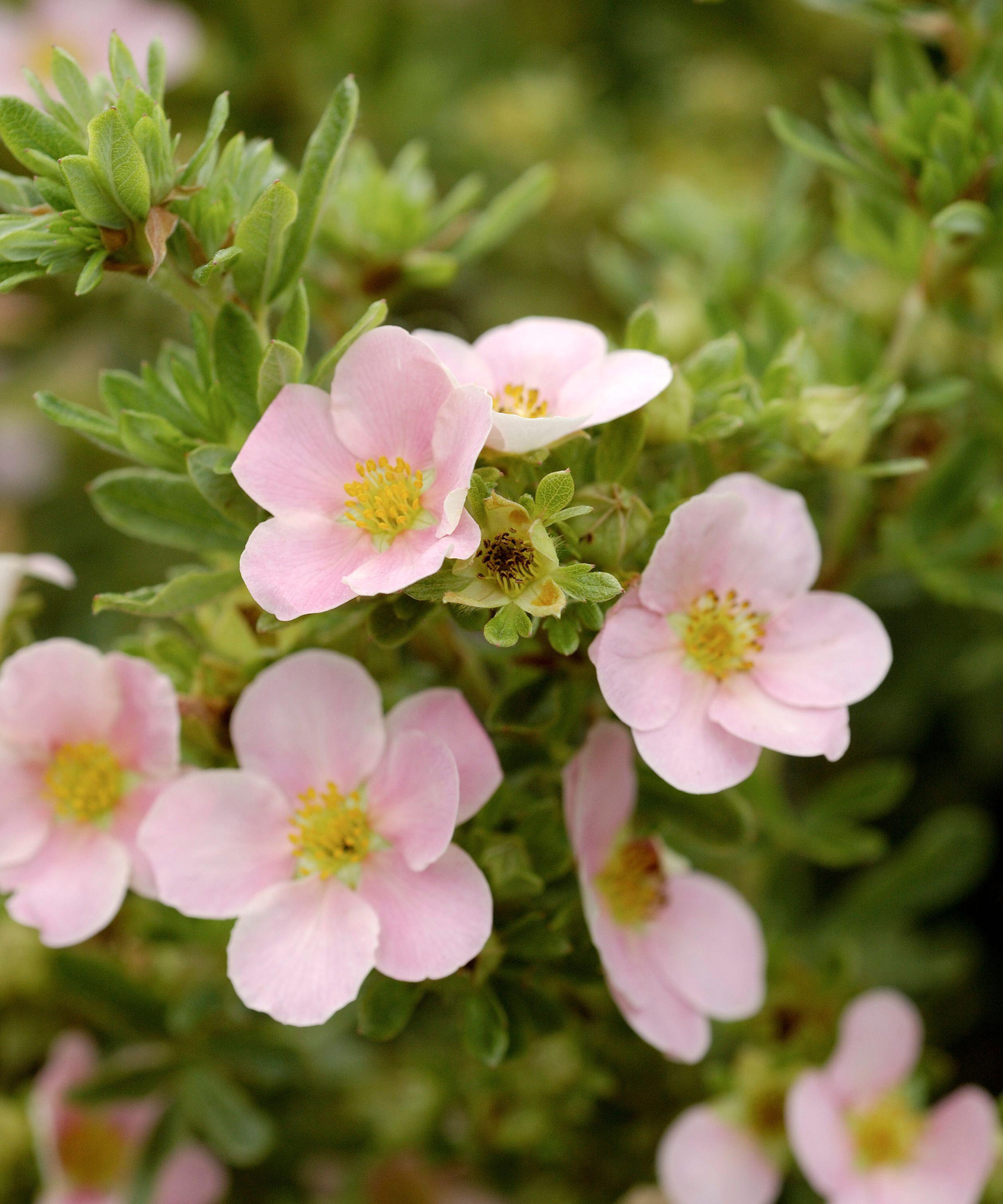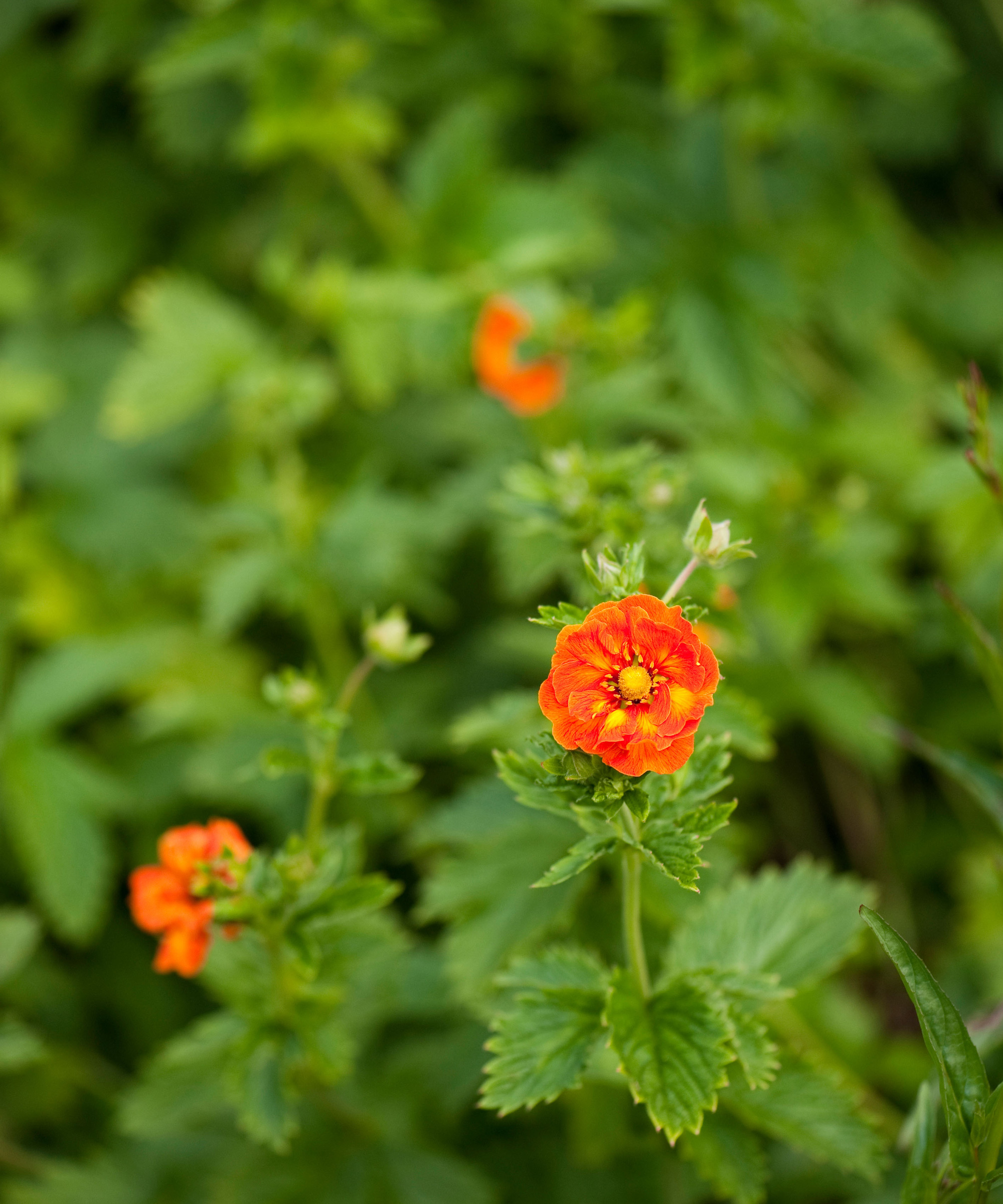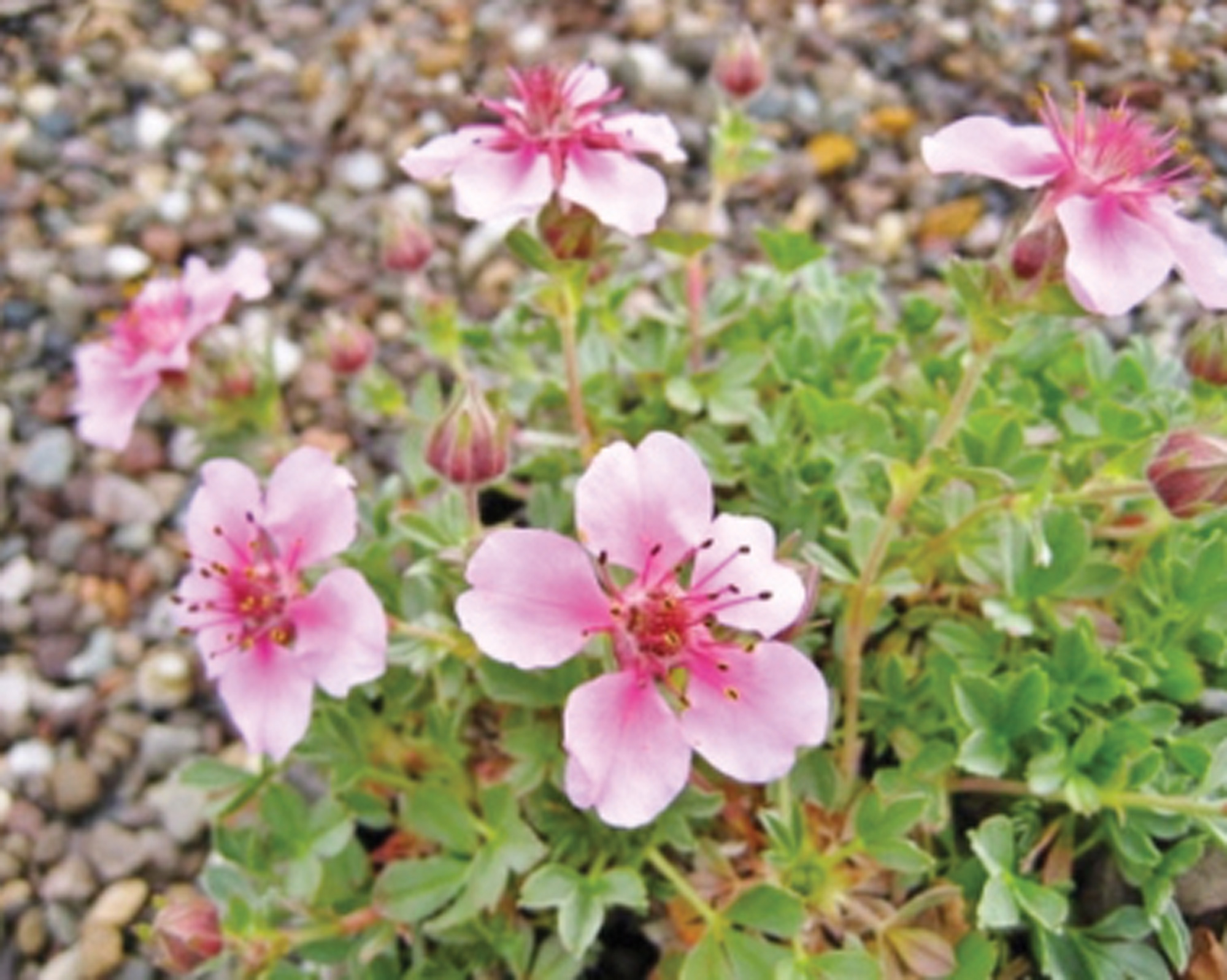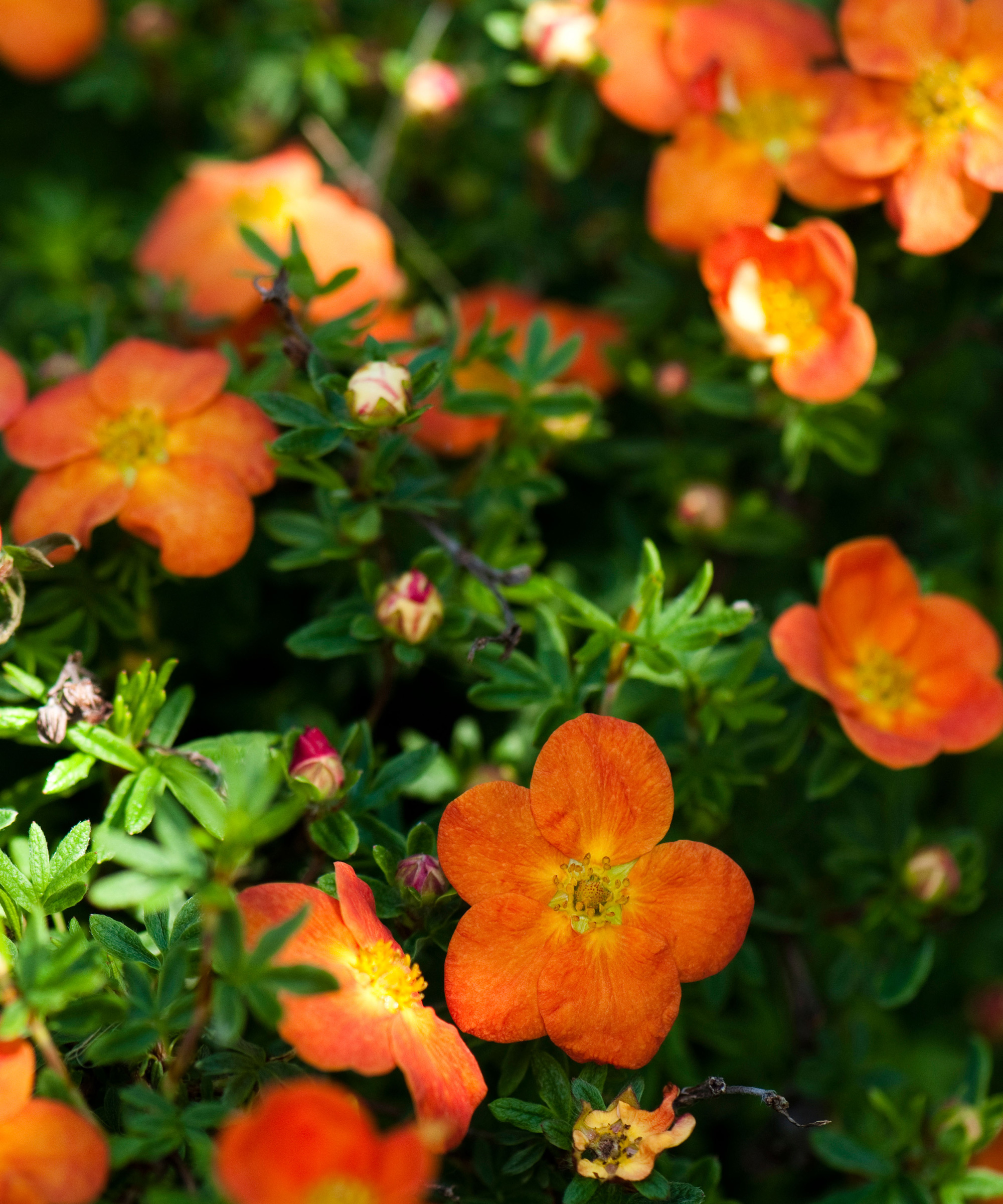Potentilla varieties: 15 pretty types to take your pick from
Long-flowering potentilla varieties bring a lot to a small garden and you'll soon discover why they're so in demand


There are hundreds of potentilla varieties to choose from and they make excellent garden plants. What they all have in common is a five petal flower structure, a little like the flowers of single roses but smaller, about 1in-3in (2.5cm-7.5cm) across. Beyond that, they can be split into three main groups.
The most widely grown are the shrubby types called Potentilla fruticosa. These make very cold hardy, twiggy deciduous shrubs, usually of small to medium height, that carry a succession of flowers from late spring to late autumn, depending on the variety. Yellow is the most common color for the flowers, but orange, red, pink and white flowered varieties are also available.
The foliage is split into five fingers, giving rise to the common name of Shrubby Cinquefoil, and varies from dark green to silver. The many potentilla varieties differ mainly in their flower color, the size and shape of the mature plant and the flowering season. Although found in the wild in both damp and dry places, in the garden they seem to prefer well-drained soil in sun.
There is also a smaller group of hardy perennial potentillas, most of which make a tight crown from which strawberry-like leaves emerge together with clusters of summer flowers in yellow, pink or red. They are closely related to strawberries.
Finally, there are very low-growing alpine or rock garden types, which like full sun and gravelly soil, and tend to spread out far wider than their height. They carry spring flowers in a variety of shades.
They're one of the best summer flowering shrubs you can add to your garden and there's plenty of choice.
Grow stunning flowers with these potentilla varieties
So how do you decide between shrubby, hardy or alpine potentilla varieties? That's easy with our handy guide to the best ones to choose. Here's our round-up of the 15 best potentilla varieties to incorporate into your flower bed ideas.
1. ‘Abbotswood’

- Type: Shrub
- Hardiness: USDA 2 (RHS H7)
- Height: 3ft (90cm)
- Good for: Small gardens, the front of sunny borders, rock garden specimens, containers
Slightly spreading plants carry an impressive show of single, white flowers through a long season from late spring to fall, nicely set off by dark green foliage.
In spite of growing on streamsides and lake margins in the wild, they will do best in full sun in fertile but well-drained soil.
There are lots of summer container ideas that potentillas will happily mix into, while Euphorbia myrsinites, Cerastium tomentosum will make good planting partners too.
2. ‘Hopleys Orange’

- Type: Shrub
- Hardiness: USDA 2 (RHS H7)
- Height: 18in (45cm)
- Good for: Small gardens, the front of sunny borders, low hedges
This relatively dwarf, spreading variety has bright green foliage, with unusually narrow leaflets and bright orange flowers that fade a little as they mature and are often narrowly edged in yellow.
Best in full sun in fertile but well-drained soil, a little dappled shade will reduce the fading in the flowers.
Combine this variety with Eschscholzia ‘Apricot Chiffon’ and Tropaeolum polyphyllum for a stunning garden color scheme.
The Hillier Manual of Trees & Shrubs reminds us: 'The shrubby potentillas are rich in good qualities; they are very hardy, dwarf-medium sized shrubs, thriving in any soil, in sun or partial shade. Their flowers, like small single roses, are displayed over a long season.'
3. ‘Limelight’

- Type: Shrub
- Hardiness: USDA 2 (RHS H7)
- Height: 3ft (90cm)
- Good for: Small gardens, the front of sunny borders, rock garden specimen, containers
Exceptionally fresh green foliage makes a fine background for the flowers that are yellow in the center and almost white at the edge. Blooms over an unusually long period from mid spring to mid fall.
Best in full sun in fertile but well-drained soil as part of your low maintenance flower bed ideas, or grow them in well-drained soil in a container.
And if you choose to make potentillas the stars of your small rock garden ideas, you won't be disappointed.
Good planting partners for this variety include Sedum spathulifolium ‘Purpureum’ and Thymus serpyllum ‘Snowdrift’.
4. Marian Red Robin (‘Marrob’)

- Type: Shrub
- Hardiness: USDA 2 (RHS H7)
- Height: 3ft (90cm)
- Good for: Small gardens, the front of sunny borders, rock garden specimen
Bright red summer flowers cover low, spreading plants. This variety of potentilla is slightly deeper in color than the old red favorite ‘Red Ace’ but tends to fade towards orange in full sun.
Best in fertile but well-drained soil, it retains its color best in bright but not fiercely sunny conditions. Combine with Campanula garganica Dickson’s Gold’ and Penstemon pinifolius.
Remember potentillas are one of the best plants for small gardens so be sure to add them to the mix.
5. ‘Medicine Wheel Mountain’

- Type: Shrub
- Hardiness: USDA 2 (RHS H7)
- Height: 12in (30cm)
- Good for: Small gardens, the front of sunny borders, ground cover, spreading over low walls
Uniquely low and spreading in growth, the very large yellow summer flowers face upwards from a pretty mat of slightly bluish foliage. Discovered growing wild in Utah.
If you are looking for the best ground cover plants, these are tolerant and adaptable, but do best in full sun and well drained soils. They will be drought tolerant when established.
Planting partners include Acaena ‘Copper Carpet’ and Armeria ‘Ruby Glow’.
6. ‘Pink Beauty’

- Type: Shrub
- Hardiness: USDA 2 (RHS H7)
- Height: 3ft (90cm)
- Good for: Small gardens, the front of sunny borders, a low hedge, rock garden specimen
Another compact, long flowering variety with silvery pink single and semi-double flowers set against bright green foliage. The flowers tend to be paler in the center and silvery white on their back.
Best out of a long day of direct sun, it's also happy in well-drained soils and containers. This variety is also a great low-growing option if you're searching for something a little different for landscaping with hedges.
Team with the subtle pink and white tones of Dianthus ‘White Ladies’ and Geranium ‘Ballerina’ for a pretty planting combination.
7. ‘Primrose Beauty’

- Type: Shrub
- Hardiness: USDA 2 (RHS H7)
- Height: 4ft (1.2m)
- Good for: Small gardens, the front of sunny borders, a rock garden specimen
Pretty, two-tone yellow flowers in a genuine primrose yellow, shading darker in the center, smother low-spreading plants with arching growth and slightly greyish leaves.
Best in well-drained, fertile soil, and it may need a little thoughtful pruning to show off its elegant branching.
Campanula poscharskyana and Phlox subulata ‘McDaniel’s Cushion' are our choice of planting partners for this variety.
8. Princess (‘Blink’)

- Type: Shrub
- Hardiness: USDA 2 (RHS H7)
- Height: 24in (60cm)
- Good for: Small gardens, the front of sunny borders, a rock garden specimen
Very pretty, blushed white, slightly cup-shaped flowers are rosier as they open then fade as they mature. Sometimes flowers have a few extra petals, and this variety makes a spreading plant with rich green foliage.
For the best chance of ensuring it will retain its blushed coloring, you should plant it in partial shade, not full sun.
Team with Artemisia schmidtiana and Dianthus ‘Gran’s Favorite’.
9. ‘Red Ace’

- Type: Shrub
- Hardiness: USDA 2 (RHS H7)
- Height: 3ft (90cm)
- Good for: Small gardens, the front of sunny borders, gravel gardens, low hedges
If you're landscaping with gravel in your plot, this is one of the top potentilla varieties to go for.
It's famous as the first red-flowered shrubby potentilla but, more accurately, the flowers are bright more orange-red in color and brightened by golden eyes and creamy backs to the petals.
This is another potentilla variety that will retain its color without all-day full sun, so find it a shady spot in your plot. Eschscholzia caespitosa and Helianthemum ‘Jubilee’ will make good plant partners.
10. ‘Gibson’s Scarlet'

- Type: Perennial
- Hardiness: USDA 5 (RHS H7)
- Height: 18in (45cm)
- Good for: The front of a perennial or mixed border
Intense scarlet, single or sometimes semi-double, bowl-shaped flowers are darker towards the center and beautifully set off by rich green, lobed foliage that develops into tight clumps.
Happy in full sun and rich, but well-drained conditions, protection from the midday sun helps extend the flowering season.
Deadhead by cutting the flowering stems out at the base and remember as perennial plants they'll come back next year too.
Up the drama by teaming this variety with dark-leaved heucheras and Artemisia ‘Boughton Silver’.
11. ‘Monsieur Rouillard’

- Type: Perennial
- Hardiness: USDA 5 (RHS H7)
- Height: 18in (45cm)
- Good for: The front of a perennial or mixed border
Semi-double flowers in mahogany red, fired over in orange and with irregular golden flashes, open in clusters through the summer and all set against attractive neatly toothed foliage.
They are easily grown in any fertile soil that is neither parched nor waterlogged. Deadhead by cutting the flowering stems out at the base, and combine with Geranium renardii and Hebe ‘Pagei’.
12. ‘William Rollisson’

- Type: Perennial
- Hardiness: USDA 4 (RHS H6)
- Height: 18in (45cm)
- Good for: The front of a perennial or mixed border
Leaves like strawberries make an attractive background for the semi-double, orange flowers unpredictably twisted and sparked in yellow and with yellow backs to the flowers.
Happy in full sun and rich, but well-drained conditions in a mixed garden border. Deadhead by cutting the flowering stems out at the base.
Lychnis ‘Vesuvius’, Weigela Wine and Roses (‘Alexandra’) would make excellent plant partners.
13. Potentilla neumanniana ‘Nana’

- Type: Alpine
- Hardiness: USDA 3 (RHS H7)
- Height: 3in (7.5cm)
- Good for: Gravel gardens, raised beds, cracks in paving, low-maintenance plantings, ground cover
This low, creeping, exceptionally winter-hardy plant features neatly lobed, dark green foliage that stays low and spreads widely. Its yellow, buttercup-like flowers with a deep golden mark at the base of each petal open in spring and summer.
Happiest in full sun and well-drained soil, it's one of the best alpine plants if you're looking for a low maintenance choice. It will work well alongside sempervivums and Euphorbia rigida.
14. Potentilla nitida ‘Rubra’

- Type: Alpine
- Hardiness: USDA 5 (RHS H4)
- Height: 2in (5cm)
- Good for: Raised beds, troughs, gravel gardens, trailing over low walls
Makes tight mats of low, creeping silvery green foliage and, in spring, the five petalled flowers open, each is white shading through rosy tones to cerise in the center.
Demands gritty, well-drained soil in full sun and will not flower in poor light. This is one of the best potentillas if you're looking for plants for covering walls.
Plant alongside Lewisia ‘Ashwood Strain’ and Pulsatilla vulgaris.
15. Potentilla x tonguei

- Type: Alpine
- Hardiness: USDA 5 (RHS H5)
- Height: 6in (15cm)
- Good for: The front of a sunny border, ground cover
This valuable, clump-forming plant develops low spreading stems from its tight crown, each carrying bowl-shaped apricot pink flowers with dark red eyes all through the summer. It is an evergreen in mild areas.
Growth can be too vigorous in rich conditions, so a site in full sun with good drainage is ideal. Team it with Berberis ‘Concorde’, Cistus ‘Silver Pink’.
Are there any evergreen potentilla varieties?
All the shrubby potentillas (Potentilla fruticosa) are deciduous and while some may retain their foliage until early winter, in all potentilla varieties the leaves eventually drop leaving a twiggy bush to see the plant through the winter.
Perennial and alpine potentillas die back completely for the winter, although a few including Potentilla x tonguei may remain green in mild areas.
What variety of potentilla will grow in the shade?
There are no potentillas that prefer growing in the shade, but shrubby potentilla varieties with red or orange or pink flowers retain the richness of their flower color better when not subjected to a long day of direct sun.
In practice, this means siting them where they are protected from the sun from the side for part of the day, so ether by a fence, garden wall or a taller evergreen.
Potentilla varieties whose color can be preserved by protection from the sun include: ‘Gibson’s Scarlet’, ‘Hopley's Orange’, Marian Red Robin (‘Marrob’), Princess (‘Blink’) and ‘Red Ace’.

Is it right that shrubby potentillas have had their names changed?
Yes. The botanists have been re-assessing potentillas and have decided that the shrubby potentillas (Potentilla fruticosa) that we all know and love, should now be treated separately and called Dasiphora fruticosa.
They have also recommended a number of other changes but it will take some time for nurseries to catch up with this.

Are potentillas deer resistant?
Shrubby potentillas are not 100% guaranteed deer-resistant plants but the experts at the New Jersey Agricultural Experiment Station them as 'Rarely Damaged'.
Deer prefer most other plants and will only feed on Potentilla fruticosa as a last resort. Perennial and alpine types seem less resistant.
Are there any native potentillas?
The shrubby cinquefoil (Potentilla fruticosa) is native to many colder areas of the Northern Hemisphere including Russia, Britain and North America and is also even found as far south as California, Arizona and New Mexico.
There are also a number of other native species, perennials and alpines, and although some of them can be nasty weeds some are worth a place in the garden. Take local advice.

Where to buy potentillas
Where to buy potentillas in the US:
- Shop potentillas at Amazon
- Shop potentillas at Bluestone Perennials
- Shop potentillas at Lowe's
- Shop potentillas at Monrovia
- Shop potentillas at Nature Hills
Where to buy potentillas in the UK:

Graham Rice is a garden writer who has won awards for his work online, and in books and magazines, on both sides of the Atlantic. He is a member of a number of Royal Horticultural Society committees and the recipient of the 2021 Garden Media Guild Lifetime Achievement Award.
